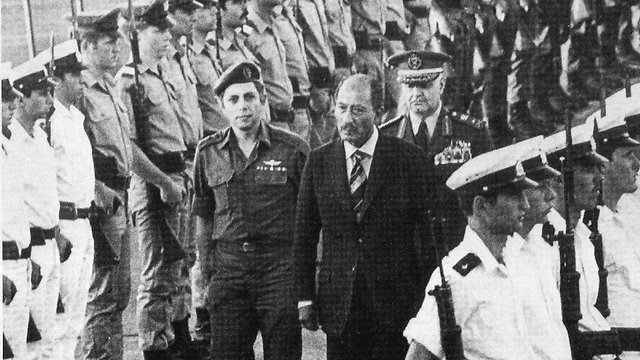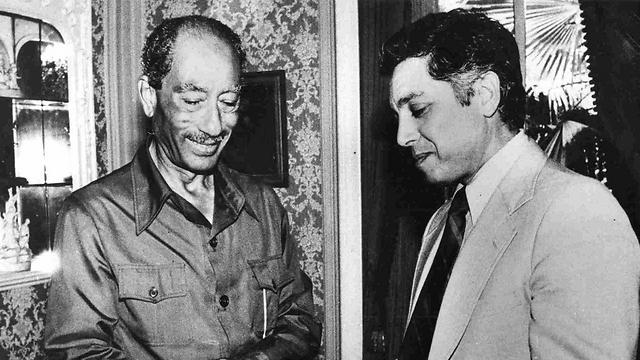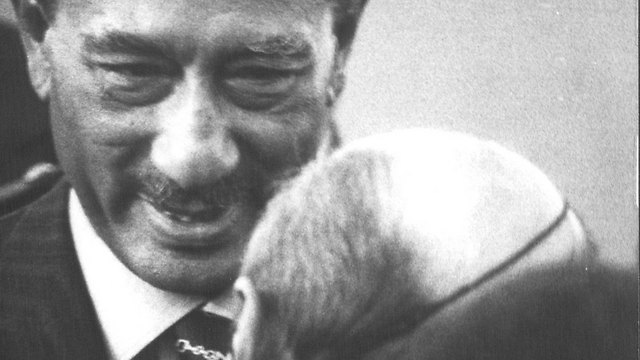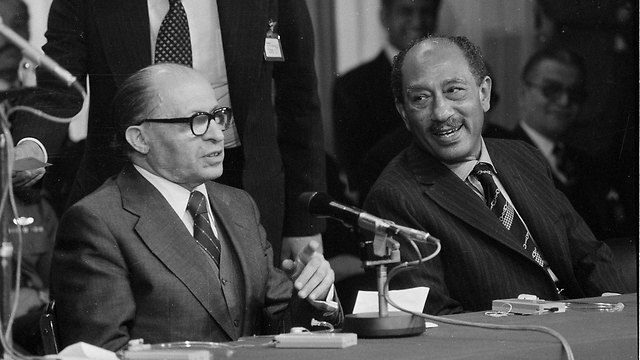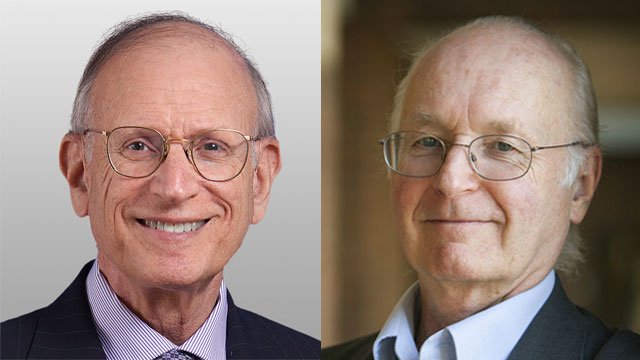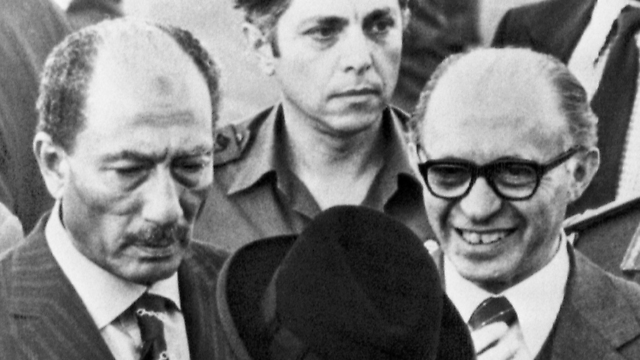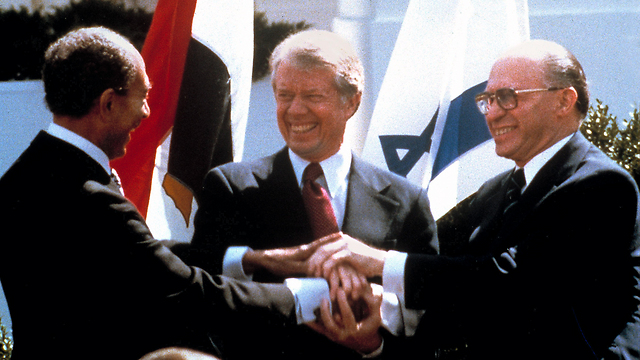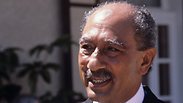

40 years since Sadat visit: ‘Israel had snipers ready on the rooftops’
On November 19, 1977, an Egyptian Air Force plane landed at Ben-Gurion Airport, carrying the person who—until that moment—had been Israel’s bitter enemy: Egyptian President Anwar Sadat. The people who were there recount the historic occasion and the events that led up to it. ‘It was clear to both sides that we had reached a deadlock in the wars,’ says former Cabinet Secretary Aryeh Naor.
But then the door opened, revealing the person who—until that moment—had been Israel’s bitter enemy: Egyptian President Anwar Sadat.
The next day, Sadat visited the Knesset and delivered his historic speech, declaring: “I come to you today on solid ground, to shape a new life, to establish peace. We all, on this land, the land of God; we all, Muslims, Christians and Jews, worship God and no one but God.”
Exactly 40 years after that historic occasion, we spoke to the people who were there.
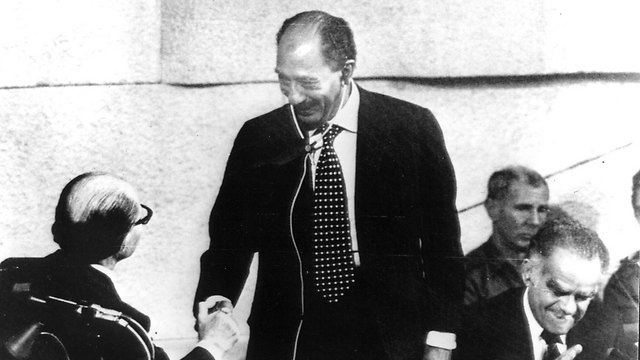
“It was an extremely exciting event,” says Roni Milo, who served as a Knesset member and as chairman of the Likud faction at the time. “He was the first Arab leader to arrive, and not just any Arab leader, but the leader of the biggest Arab country. Egypt is not some small country, it’s a country we had a horrible war against, the Yom Kippur War. Making peace with them was a historical vision.
“The image of Knesset Speaker Yitzhak Shamir, Prime Minister Menachem Begin and the Egyptian president sitting together at the Knesset sends shivers down my spine to this very day. It’s a key event in Israel’s history by any measure. Two years after he was elected prime minister, it was Begin, who everyone had said would lead to war, who hosted Sadat at the Knesset, and a peace agreement was eventually signed with Egypt.”
Sadat was received with great enthusiasm by the Israeli public. Prime Minister Begin, President Ephraim Katzir and the state’s top officials were there to greet him, including the person who served as his aide-de-camp during the visit, Menahem Milson, a professor of Arabic language and literature at the Hebrew University of Jerusalem.
“Sadat’s visit to Israel was one of the most important events in the history of the state,” Milson says. “When I was Informed of my appointment as the aide-de-camp for the visit, I was very happy. It’s an event which changed Israel’s status in the region. I saluted Sadat and greeted him in Arabic. He was very surprised by my Arabic, raised his hands and shouted, ‘Bravo!’ It was a very exciting moment for me, and it’s a memory that lives in my heart to this very day.
“I had to shape the position. I composed the wording of the greeting myself, because the IDF didn’t have an Arabic version that was acceptable in Arab states, so I had to decide on my own how to fill the role.”
Charlie Biton, who served as an MK on behalf of the Hadash party at the time, recalls the historic occasion too. “I supported Sadat’s arrival in Israel,” he says. “We believed wholeheartedly that we were kicking off an important and serious process that would lead to peace between all of the region’s people. Egypt was the most important thing. The entire nation was excited, not just we.”
“Sadat’s visit didn’t come out of the blue and didn’t happen one bright day,” says Aryeh Naor, the cabinet secretary at the time. "The ground was prepared, and people worked very hard on it. With all due respect to the visit, the goal was to make peace. It was clear that the visit had to be formal and friendly, like two countries with peaceful and friendly relations rather than enemies. But while the atmosphere is important, what really determines historic moves is decisions and things that are conducted in secrecy”
‘Begin chose peace over Sinai communities’
Six months earlier, the political upheaval and the hawkish Begin’s election victory, raised concerns in the Arab world and in the United States over the possibility of peace in the region. Begin was against a withdrawal from the Gaza Strip and the West Bank, for example, and saw them as part of the State of Israel. He also quit the unity government in 1970 in protest of its decision to accept the Rogers Plan and United Nations Resolution 242, which called on Israel to withdraw from the territories it occupied in 1967. Despite his views, however, Begin did see it fit to negotiate with the region’s countries in a bid to reach peace agreements.
“Begin and Moshe Dayan’s opinions changed,” Naor adds. “Immediately after the Six-Day War, Dayan said that if he had to choose between peace with Egypt and controlling Sharm el-Sheikh, he would choose Sharm el-Sheikh. After Sadat arrived, he declared: ‘If I have to choose between peace and Sharm el-Sheikh, I choose peace, and if you ask me what made me change my mind, I have two answers. The first is that only a donkey doesn’t change his mind, and the second is that when I said I preferred Sharm el-Sheikh over peace, peace wasn’t at arm’s length.’ Begin was known as a great hawk, and suddenly he gave up Sinai. These people went through an interesting conceptual process, and it led to results.”
The change in the Israeli and Egyptian governments’ state of mind is attributed to the Yom Kippur War. “It was clear to both sides that we had reached a deadlock, and that the wars weren’t ending with an unequivocal defeat of the enemy,” Naor adds. “While the IDF won from a military perspective, it became clear to us that the wars were taking a heavy toll and that we could not rely on a miracle to happen again, like in the Six-Day War.
“The ground had been prepared, and the people were more mature. Begin realized that the only way to prevent the creation of an Arab coalition that would threaten the state’s existence was by removing Egypt from the circle of war. To do that, there was a need to reinforce Sadat’s tendency to disconnect from the Soviet Union and team up with the US, and to present a peace initiative that would satisfy the Egyptian desires, and that’s what Begin did.
“He linked the whole process to the US, and it wasn’t simple. There was an opposition within the government too. Defense Minister Ezer Weizman believed that the deal should be finalized face-to-face with Sadat alone. But Begin insisted and wanted the Americans in the picture so that the peace, if achieved, would also last.
“At first, they tried to leave the Sinai communities out of it and searched for all kinds of solutions and legal deals, and when it turned out that there was no choice and that he had to choose between the communities and the agreement with Egypt, Begin chose the agreement.”
The evacuation of the Sinai communities produced difficult images. IDF soldiers were documented being attacked by the evacuees, and the settlers’ pain stirred up emotions among the Israeli public. Begin defended the peace by saying: “We are fighting for peace today. We are blessed to have reached this point. Yes, there are difficulties in peace, there is pain in peace, there are victims for peace. They are all preferable to the victims of war.”
On March 26, 1979, Israel and Egypt signed the peace treaty. The Israeli Embassy in Cairo was opened in February 1980.
‘Sadat initiative pushed talks in wrong direction’
Stuart Eizenstat, who served as US President Jimmy Carter’s political advisor, and Prof. William Quandt, who was a National Security Council member and the administration’s envoy on Middle Eastern affairs, were both personally involved in the negotiations that led to the Camp David Accords in 1978. Forty years after the Sadat visit, they reveal a completely different picture from the Israeli and global public’s perception of the Egyptian president’s gesture. According to them, the historic visit nearly thwarted the efforts for a dialogue between the two countries.
The importance of the visit, Eizenstat says in a special interview to Ynet, was to clear the air in regards to the continuation of the peace process. “Sadat broke a major taboo in the Arab world—a visit to Jerusalem. It showed everyone that he was willing to talk. Personally, I thought the visit would be an event that would change the rules of the game, but I didn’t share the euphoria.”
Indeed, from the American point of view, Sadat’s initiative pushed the talks in the wrong direction and almost led to a complete halt.
Sadat’s visit, Eizenstat and Quandt say, was actually a subversive defiance of the White House and the comprehensive peace initiative that was being devised there, which aimed to bring together representatives from Israel, Egypt, Syria, Jordan and the Palestinians in Geneva.
Despite the difficulties concerning the Palestinian representation at the conference, Carter managed to enlist Soviet leader Leonid Brezhnev to support the initiative. On October 1 1977, the US and the Soviet Union issued a joint statement on their diplomatic vision for the Middle East—a memorandum of understanding which put the Israeli government and Sadat under pressure.
While the Jewish community expressed its resentment and got Carter to declare his unconditional support for Israel, Egypt had no hold on the American public. That was when Sadat decided to make an unequivocal move, out of a desire to get closer to the US and avoid an international conference that would make it difficult for him to accomplish his most important task: Returning Sinai to Egypt—a matter he favored over the Palestinian problem and other issues on the Arab world’s agenda.
“Sadat watched all this from the side, and decided about the visit because he believed the Geneva conference had no chance of succeeding. He didn’t want to give (Syrian President) Hafez Assad a right to veto Egypt's moves. He understood that he had to take a one-sided initiative,” says Eizenstat.
Quandt reveals that Carter tried to include Sadat in the plans and sent him a personal telegram in his handwriting, asking for his help in jumpstarting the process: “This is where his idea to do something dramatic in Jerusalem was raised, but his proposal was groundless and impractical—to hold a summit of Arab leaders and the UN Security Council in Jerusalem.”
Quandt believes Sadat was annoyed by the Americans’ negative response and broke off contact. The next time he was heard was on November 9, when he addressed the Egyptian parliament and announced his willingness to visit Jerusalem. “The hint was that if we failed to cooperate with his initiative, he would make his own move.”
Quandt, the author of “Camp David: Peacemaking and Politics,” is a professor emeritus in the Department of Politics at the University of Virginia. Sadat’s speech, he notes, was preceded by a dialogue brokered by the king of Morocco between Foreign Minister Moshe Dayan and Egyptian Deputy Prime Minister Hassan Tuhami—talks which led nowhere, he says.
Nevertheless, many in the American administration were shocked by Sadat’s willingness to travel to Jerusalem. A phone call from the Egyptian foreign minister assured them that it was merely propaganda and nothing else, but Sadat spoke to US Ambassador to Egypt Hermann Eilts and admitted that his intentions were serious. Ten days later, he landed in Israel, surprising the Americans and the entire world.
‘Carter has no choice’
“We didn’t know a thing about the visit. It took us completely by surprise,” Eizenstat recalls. “Carter was angry about this initiative because it affected his plan for a comprehensive peace initiative. But he realized that it really was a historic occasion, and he had no choice but to join the initiative. He was determined, however, to leave an opening in the agreement for the incorporation of a solution for the Palestinian problem.”
Quandt agrees: “Carter was disappointed by this move. He found it difficult to accept the fact that his original initiative was being violated and that he had to change his approach. The surprised Carter’s first response wasn’t positive, but he quickly realized that this was an important message from Sadat, which we had to leverage in favor of the process. It led to a substantial change in our strategy. We had to decide whether to join his initiative or to try to convince him to slow down. Eventually, we had no choice. We had to support Sadat, knowing that he was endangering his position in the Arab world and that we were the compensation for that. He trusted us.”
The Israelis were less surprised, as the visit had been secretly coordinated with them. Nevertheless, there were suspicions.
“We knew the Israelis were ready with snipers on the airport rooftops, because they were afraid Sadat was deceiving them and that he had Egyptian commando soldiers on the plane with him, who would attack and assassinate the Israeli leadership,” Quandt says. “But at the point Sadat was the air, they knew everything was in order. Barbara Walters herself informed the Israelis in advance that there was no cause for concern.”
“It was a bloodcurdling moment,” Eizenstat recalls. “Some thought it was a trap, but Begin had no hesitations. He knew it was a necessary step.”
Quandt says the Israeli leadership was at odds over the proper response to the gesture: “Dayan was impressed by Sadat, but he didn’t get emotionally carried away. He was willing to meet Sadat halfway, but he doubted he would have the courage to turn his back on the Arab world.
“Ezer Weizman was the optimist one among them. He thought the visit was a fantastic move and that Sadat was the real thing. He believed it was a breakthrough and acknowledged the fact that Sadat had taken a big risk and that Israel should reward him by returning Sinai and finalizing the deal. Aharon Barak (the cabinet secretary at the time) estimated that an agreement was possible too, but insisted on embedding the speech in a legal infrastructure.
And what about Begin?
“Begin was difficult to read. He kept his cards close to his chest. He wasn’t excited about the visit and didn’t feel it had any meaning as part of the negotiations. He told us it was a good thing that Sadat had come, but he didn’t see it as any concession on his part. We were impressed by Sadat’s move, but every time we got carried away, Begin was there to curb our enthusiasm. He made sure to declare that he had no intention of returning all of Sinai to Egypt. We knew he was holding onto his last card, and we assumed he would let go of it eventually. It did happen, but only on the last day at Camp David.”
On the personal level, what was supposed to be Sadat and Begin’s first date ahead of a love story, eventually left the Egyptian president brokenhearted.
“Sadat wanted to break the psychological barrier and show the Israelis that he was willing to talk peace. We thought he was ready, but we never imagined he would cause such a fundamental change in the Israeli public opinion and improve his image. I remember watching the live broadcast of him getting off the plane, smiling, hugging Golda Meir and shaking Ariel Sharon’s hand. It was unbelievable, but the visit failed to create a friendly relationship between Sadat and Begin. It didn’t happen there,” Quandt clarifies.
Begin’s stubbornness and his unwillingness to meet Sadat halfway shattered the Egyptian president’s dream and almost shattered the dream of peace in the Middle East.
“The negotiations that followed the visit, before Camp David, were very inefficient,” says Eizenstat. “Begin wouldn’t compromise and Sadat was very, very frustrated about it. He said, ‘Here’s me making a huge historic gesture and putting my political career and my life at risk, while this man—meaning Begin—isn’t ready for a full withdrawal from Sinai.’ He was unable to understand this refusal.”
Sadat repeatedly referred to Begin as “this man” during the period that followed the visit. “The visit was misleading, because it created a false feeling that Israelis and Egyptians could sit down and solve the problems themselves, but it was quickly revealed that this wasn’t the case,” says Quandt.
“When Sadat returned from Jerusalem, he told associates that he never wanted to meet ‘this man’ again. ‘I did what I had to do, I offered them peace,’ he asserted. Sadat thought his gesture was a significant move, but Begin saw it as merely a first step in long and complex negotiations. Sadat expected a declaration on Israel’s willingness to withdraw from all the occupied territories, and when that didn’t happen he felt betrayed.”
So after the euphoria of the visit, the next morning arrived, and it was particularly grim as far as Sadat was concerned. Suddenly, he lost interest in the process he had initiated, and tried to avoid further meetings with Begin.
“We told him he couldn’t do that. Begin is a man of small details and he would want to discuss everything, apart from the Palestinian problem. But he said he couldn’t bear the thought of meeting with him again,” says Quandt, adding that Egyptian leader was shocked when the Americans asked him to invite the Israeli prime minister to make a reciprocal visit to Cairo. Having no other choice, he agreed to host him in Ismailia.
“Immediately after the elation of the Jerusalem gesture, everything faded away. The meeting in Ismailia, which was successful as far as Begin was concerned, left Sadat disappointed. He actually entered a state of depression after it. Everything fell apart. We knew that without American mediation it wouldn’t work.”
And so, several weeks after he defied Carter and his comprehensive peace plan, and launched his own one-sided initiative, Sadat was forced to return to the American president, helpless. In February 1978, Carter invited Sadat on an intimate weekend at Camp David in an effort to cheer him up and restart the negotiations.
“When we came into the picture, we saw a very sad Sadat smoking a pipe. He was really depressed. He really hated Begin,” Quandt recalls.
Eizenstat says everything seemed hopeless until Carter came in as mediator: “As a matter of fact, Sadat and Begin met just twice at Camp David, in the beginning and in the end. Begin nearly walked away from the talks following another unreasonable demand made by Sadat, and Carter realized that if he wanted the negotiations to succeed, he had to take matters into his own hands with Weizman and Dayan’s help.”
Sadat was highly appreciated by the Israeli public for his initiative and courage, but the Egyptian leader did not enjoy the same appreciation in his own country.
“Sadat was a very special leader. When he came to Jerusalem, the Egyptian public was in shock,” says Quandt. “He took a huge risk and he couldn’t afford to fail. It’s a step of to be or not to be.
“Most people around him thought that Sadat—like the Americans see Trump—was unpredictable. They always made it clear that it was his own initiative and that he didn’t ask them what to do. There was always a lot of support for an agreement among the public, but the expectations for prosperity in in Egypt weren’t realized. The feeling was that Israel had gained much more from the deal. So when Sadat was murdered, he wasn’t mourned by many people. We’ll likely still see no celebrations in Egypt to mark the visit’s anniversary.”
So did Sadat’s visit, which was a groundbreaking move, leave any political legacy? Quandt believes it was a one-sided initiative, which is a rare thing in the Arab world, and not many people are willing to follow in his footsteps.
“Sadat made his move without any preconditions, and without any promise for a reward. That’s what happened to Yasser Arafat too, because Yitzhak Rabin never promised him anything in advance. You have to be a self-confident leader to take such a huge step without any promises. That was the difference between them and Hafez Assad, for example, who was unwilling to enter negotiations without preconditions. The leaders of the Arab world feel vulnerable when it comes to the internal arena. Sadat was willing to break the rules and pay a price for it, while others look beyond their shoulder for their political survival.”














